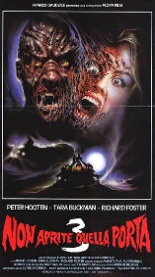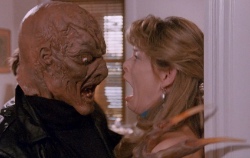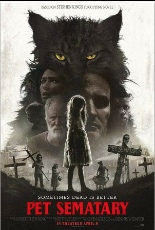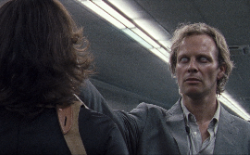
 To celebrate high school graduation, four couples have concocted an utterly monstrous, mind-roasting plan: to spend the night in a furniture store. And not just any furniture store, but Fine Furniture downtown, whoa-ho! John (Sean Kanan, The Karate Kid Part III) even knows the ropes — because Dad owns the place — so it’s going to be totally bitchin’! On the agenda are beer, food and, of course, sex in the showroom beds.
To celebrate high school graduation, four couples have concocted an utterly monstrous, mind-roasting plan: to spend the night in a furniture store. And not just any furniture store, but Fine Furniture downtown, whoa-ho! John (Sean Kanan, The Karate Kid Part III) even knows the ropes — because Dad owns the place — so it’s going to be totally bitchin’! On the agenda are beer, food and, of course, sex in the showroom beds.
Seeing the maze of mattresses and mannequins scattered across the joint’s multiple stories, Kim (Weekend Pass’ Annette Sinclair, a former Mrs. Bob Seger) suggests an epic, pre-dinner game of hide-and-go-seek. As the film’s title of Hide and Go Shriek confirms, that’s exactly what they do. The title also makes clear that some of the players aren’t going to live to see morning, because a killer is afoot.
 The only movie ever directed by one Skip Schoolnik, the obscure Hide and Go Shriek arrived well after the ’80s slasher wave crested, but deserves wider awareness. That has zip to do with the acting, which is loud and bush-league, and everything to do with an ahead-of-its-time reveal I won’t spoil. Despite editing that saps any suspense, the film lands on the slasher genre’s comfort-food side. Giving it a big shove are the effects from Screaming Mad George (Beyond Re-Animator), with an elevator decapitation as a gruesome highlight, and the gratuitous nudity, including a rather hysterical sequence in which Judy (Donna Baltron, Bikini Squad) is so nervous about losing her virginity, yet launches into a striptease act so polished, her upper thighs have to smell like dirty dollar bills.
The only movie ever directed by one Skip Schoolnik, the obscure Hide and Go Shriek arrived well after the ’80s slasher wave crested, but deserves wider awareness. That has zip to do with the acting, which is loud and bush-league, and everything to do with an ahead-of-its-time reveal I won’t spoil. Despite editing that saps any suspense, the film lands on the slasher genre’s comfort-food side. Giving it a big shove are the effects from Screaming Mad George (Beyond Re-Animator), with an elevator decapitation as a gruesome highlight, and the gratuitous nudity, including a rather hysterical sequence in which Judy (Donna Baltron, Bikini Squad) is so nervous about losing her virginity, yet launches into a striptease act so polished, her upper thighs have to smell like dirty dollar bills.
The idea of horny teens staying overnight in a department store had been done much better in 1986’s Chopping Mall, thanks to that Jim Wynorski pic’s satiric edge. By contrast, Shriek’s laughs are not intentional, what with these crazy kids’ $6 haircuts, Chinese fire drills and Bloom County T-shirts. —Rod Lott








 Luz is being sold as a horror movie in the mold of Dario Argento, Lucio Fulci and David Cronenberg. While their influence on Singer can be glimpsed, the pitch may be doing a disservice to the German film in setting audience expectations it cannot possibly meet. Those primed for a possession thriller filtered through those masters’ lenses will be ill-prepped for a near-somniferous pace that makes the slow-burn style of today’s reigning arthouse-horror hits (e.g.,
Luz is being sold as a horror movie in the mold of Dario Argento, Lucio Fulci and David Cronenberg. While their influence on Singer can be glimpsed, the pitch may be doing a disservice to the German film in setting audience expectations it cannot possibly meet. Those primed for a possession thriller filtered through those masters’ lenses will be ill-prepped for a near-somniferous pace that makes the slow-burn style of today’s reigning arthouse-horror hits (e.g.,